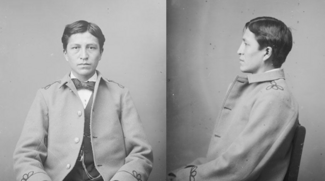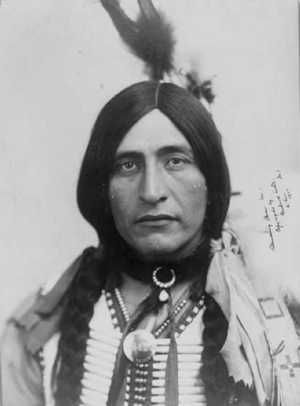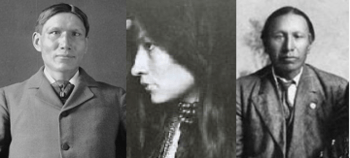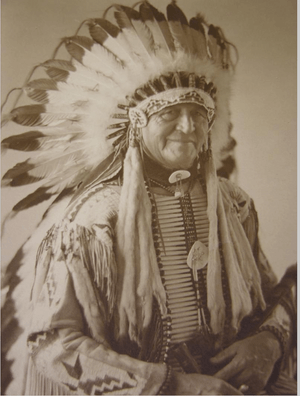Luther Standing Bear facts for kids
Quick facts for kids
Luther Standing Bear
|
|
|---|---|
| Óta Kté or Plenty Kill | |

c. 1890
|
|
| Born | December 1868 |
| Died | February 20, 1939 |
| Nationality | Sicangu and Oglala Lakota |
| Other names | Matȟó Nážiŋ or Standing Bear |
| Education | Carlisle Indian Industrial School |
| Occupation |
|
| Parent(s) | George Standing Bear (father), Pretty Face (mother) |
| Relatives | Henry Standing Bear (brother) |
Luther Standing Bear (whose Lakota names were Óta Kté or "Plenty Kill," and Matȟó Nážiŋ or "Standing Bear") was an important Lakota leader. He was born in 1868 and passed away in 1939. He was a writer, teacher, thinker, and actor.
Luther Standing Bear worked hard to keep the Lakota culture and their right to govern themselves strong. He was a key person in a movement that wanted to change how the government treated Native Americans.
He was one of the few Lakota leaders of his time who grew up learning his people's oral traditions. He also got an education in white culture. This allowed him to write books in English about his people's history. His writings shared a Native American view of life during a time of big changes in American history. He wrote about his early life, his time at the Carlisle Indian Industrial School, performing with Buffalo Bill, and living on reservations.
Standing Bear's ideas about Native American cultures taught the American public a lot. They helped people understand more and gained support to change government rules about Native Americans. He helped create the idea that Native American culture respects nature and sees everything as connected. His writings are now studied in colleges and are a valuable part of Native American thought.
Contents
Early Life
Luther Standing Bear was born in December 1868. This happened at the Spotted Tail Agency, which was in what is now South Dakota. He was the first son of George Standing Bear and Pretty Face. His father, George Standing Bear, was a chief of the Sicangu (Brulé Lakota) people. Luther was raised by his mother's family. He learned the traditional ways of a hunter and warrior.
In 1873, young Luther saw Sioux warriors come back from a big attack. They had fought a large group of Pawnee hunters in Nebraska. He later wrote about this event. He was one of the few Sioux people to share what they saw during the attack. He also wrote about his father's part in the battle.
In the late 1870s, Luther's father, George Standing Bear, opened a general store. This was the first business run by a Native American on the Spotted Tail agency. In 1879, young Luther began attending the Carlisle Indian Industrial School in Pennsylvania. Luther's father knew that white people were many and powerful. He believed that education was the way for Native Americans to survive in the "white world."
Carlisle Indian School
The Carlisle Indian Industrial School was one of the first Native American boarding schools. Its main goal was to make Native American children adopt white culture. Standing Bear was one of the first students when the school opened in 1879. When he arrived, he was asked to pick a name from a list on the wall. He pointed randomly and chose the name Luther.
Standing Bear quickly became a top student for Captain Richard Henry Pratt, who ran the school. Like many other students, Standing Bear respected Captain Pratt a lot. Standing Bear helped Pratt by explaining things and finding new students at Pine Ridge, South Dakota. He also led the Carlisle Indian Band across the Brooklyn Bridge when it opened in 1883. He even worked as a student helper for a store owner named John Wanamaker in Philadelphia.
Back on the Reservation
In 1884, after finishing his studies at Carlisle, Standing Bear went home. He had a good recommendation from Captain Pratt. He returned to the Rosebud Agency in South Dakota. There, he got a job as an assistant at the reservation's school. He earned three hundred dollars a year.
Around 1890, after the Wounded Knee Massacre, Standing Bear moved. He left Rosebud and followed his father and brother, Ellis Standing Bear, to Pine Ridge, South Dakota. At Pine Ridge, he had different jobs and family businesses. In 1891, Standing Bear became the principal of a day school on the reservation. He also worked in his uncle's small general store.
Standing Bear wrote to John Wanamaker about starting a post office on the reservation. But he was told that Native Americans were not allowed to be postmasters by law. So, a white missionary's name was used for the post office, but Standing Bear actually ran it.
Later, Standing Bear and his brother Ellis opened a dry goods store. They also started a small ranch, raising horses and cattle. Standing Bear held public meetings at his store in Pine Ridge. They discussed treaties and current events.
Family Life
Standing Bear married Nellie DeCrory in 1886. They had six children together. Around 1899, Standing Bear married Laura Cloud Shield. They had one more child.
Train Accident
In 1903, Standing Bear joined Buffalo Bill's Wild West show again. But the show season ended early on April 7, 1903. A terrible train accident happened in Illinois. Another train hit the back of Standing Bear's train cars. Three young Native Americans died, and 27 performers were badly hurt. Standing Bear was seriously injured and almost died. Because of this, Standing Bear and his family could not return to Buffalo Bill's Wild West show.
Leaving the Reservation
After recovering, Standing Bear was chosen as a chief of the Oglala Lakota on July 4, 1905. But he decided to leave the reservation later that year. He wrote that he "was no longer willing to endure existence under the control of an overseer." This meant he didn't want to live under someone else's control anymore.
Standing Bear sold his land on the reservation. He bought a house in Sioux City, Iowa. There, he worked as a clerk for a large company. After a short time performing in rodeos in Oklahoma, he moved to California. He wanted to find full-time work in the movie industry.
Hollywood and Movies
In 1912, Standing Bear moved to California. A movie director named Thomas H. Ince hired him as a consultant. This was because Standing Bear had experience performing with Buffalo Bill's Wild West. Standing Bear first appeared on screen in the movie Ramona in 1916. From 1912 to the 1930s, he worked in the movie business. He worked with famous actors like Tom Mix, Douglas Fairbanks, and William S. Hart on early Western movies. Luther Standing Bear acted in many films, playing both Native American and non-Native American roles.
Selected Films
- Ramona (1916)
- Bolshevism on Trial (1919)
- White Oak (1921)
- The Santa Fe Trail (1930)
- The Conquering Horde (1931)
- Texas Pioneers (1932)
- Massacre (1934)
- Laughing Boy (1934)
- Murder in the Private Car (1934)
- Cyclone of the Saddle (1935)
- The Miracle Rider (1935 serial)
- Fighting Pioneers (1935)
- Circle of Death (1935)
- Fighting Pioneers (1935)
- Union Pacific (1939)
Protecting Native American Actors
Standing Bear was a member of the Screen Actors Guild in Hollywood. He did not like how Hollywood showed Native Americans in movies. He believed that only Native Americans should play Native American roles. He wanted these roles to be important and meaningful. In 1926, he and other Native American actors in Hollywood started the "War Paint Club." Ten years later, Standing Bear joined Jim Thorpe to create the Indian Actors Association. This group worked to protect the rights of Native American actors. It also fought against making fun of Native American characters.
Luther Standing Bear's Writings

Between 1928 and 1936, Standing Bear wrote four books and many articles. He wrote about protecting Lakota culture. He also spoke out against government rules for Native Americans. His writings challenged government policies about education, making Native Americans adopt white culture, freedom of religion, and tribal self-rule. He also wanted lands returned and opposed efforts to make the Lakota into farmers.
Standing Bear was against the Dawes Act. This law broke up Native American tribal lands into private plots. He also criticized government support for missionaries who tried to change Sioux religion. He was against the ban on the Sun Dance, which was a very important religious and social event for the Sioux people.
Books and Articles

Between 1928 and 1934, a group of reformers started a national effort. They wanted to change government policies toward Native Americans. This effort began in 1928. That year, Standing Bear's book My People the Sioux was published. Also, the Meriam Report was released.
During this time, Standing Bear published four books and many articles. He wanted to teach the public about Lakota culture. He traveled around America, giving talks. He built support for a new set of laws called the Indian New Deal.
Standing Bear was a leader in this movement. His writings taught the American public. They helped people understand more and gained popular support to change government policies. At that time, there were very few Native American authors. Standing Bear's books were seen as very important culturally. Even The New York Times reviewed them.
In 1931, Standing Bear published My Indian Boyhood. This book is a classic story of what it was like to grow up as a Lakota child in the late 1800s. That year, after 20 years away, he visited Pine Ridge, South Dakota. He was very upset by how difficult life was for his people. So, he wrote an article called "The Tragedy of the Sioux." It was published in American Mercury. In it, he criticized the government's policies for continuing to harm the Lakota people.
His book Land of the Spotted Eagle came out in 1933. It describes traditional Lakota life and customs. It also criticizes white people's efforts to make Native Americans act like them. In 1933, Standing Bear also published What the Indian Means to America. In 1934, he published a collection of Lakota stories and legends called Stories of the Sioux.
Standing Bear and the Indian New Deal
Standing Bear was a leader in the movement for change. He worked with people like John Collier and the Indian Rights Association. They wanted to protect Native American religion and their right to govern themselves. His ideas about Native American culture and wisdom taught the American public. They helped people understand more and gained popular support to change government policies.
In 1928, Standing Bear's book My People the Sioux and the Meriam Report were published. This started an organized effort to challenge government policies that limited Native American religion and self-rule. Between 1928 and 1934, Luther Standing Bear published four books and many articles. He taught the public about Lakota culture. He also traveled around America, giving talks to build support for an Indian New Deal.
In 1933, John Collier became the commissioner for the Bureau of Indian Affairs. This was during President Franklin D. Roosevelt's time in office. Standing Bear wrote to President Roosevelt. He suggested that Congress should make laws to include Native American history and culture in public school lessons.
The next year, Collier introduced what became known as the Indian New Deal. Congress passed the Indian Reorganization Act of 1934. This law reversed 50 years of policies that tried to make Native Americans adopt white culture. Instead, it focused on Native American self-determination. It also reversed the Dawes Act's policy of breaking up tribal lands. Standing Bear's essay "The Tragedy of the Sioux" and his book Land of Spotted Eagle were published around this time. They had a big impact. They influenced Collier's Indian New Deal policies and helped fight to bring back tribal culture and self-rule.
Death
On February 20, 1939, Luther Standing Bear passed away. He was 79 years old. He died from the flu while working on the set of the film Union Pacific in California. He was buried in the Hollywood Forever Cemetery in Los Angeles, far from his Lakota homeland. His sacred pipe was buried with him.
Images for kids
-
"I left reservation life and my native people, the Oglala Sioux, because I was no longer willing to endure existence under the control of an overseer. For about the same number of years I had tried to live a peaceful and happy life; tried to adapt myself and make re-adjustments to fit the white man's mode of existence. But I was unsuccessful. I developed into a chronic disturber. I was a bad Indian, and the agent and I never got along. I remained a hostile, even a savage, if you please. And I still am. I am incurable." — Luther Standing Bear
-
Standing Bear was one of a small group of Lakota authors of his generation, such as Charles Eastman, Gertrude Bonnin, and Black Elk. They grew up with their culture's oral traditions but also learned in white culture. They then wrote important historical accounts of their people in English. Left to right: Charles Eastman, Gertrude Bonnin, and Black Elk








